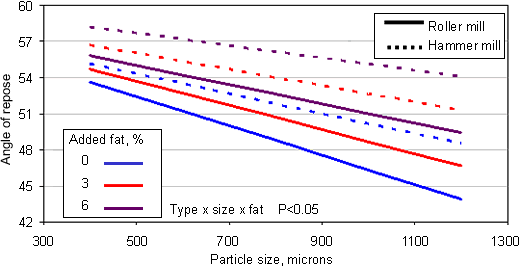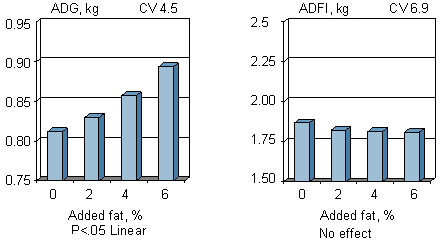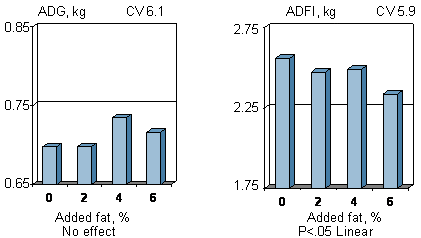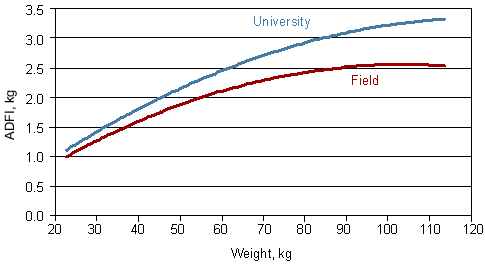Available Ingredients
From a practical standpoint in the field, the first factor that dictates dietary energy density is the selection of ingredients available at the feed mill. For example a swine producer that raises milo with on-farm feed milling and without capabilities of adding fat will have a dietary energy density of the diet dictated by whatever level will be provided by a milo protein source based diet. In contrast, a producer that has access to low cost alternative ingredients and a variety of added fat sources. This producer will require a detailed analysis of the dietary energy sources available.
Feed Processing
Feed processing capabilities and feed delivery systems are the second factor we consider. What is the consistency of grain particle size? What is the grain grinding method? Recent research from our group indicates that as expected in a corn based diet flow ability is decreased as energy density is increased with added fat (Figure 1; Groesbeck et al., 2003). The feed flow ability was characterized by the angle repose. A higher angle of repose indicates that the feed flow ability is poorer. Also, note that roller mill ground grain has better flow ability than hammer milled grain. Feed bin cone angle and condition and diameter of feed lines are also factors that can impact flow ability due to added fat or decreased bulk density from adding fibrous ingredients. Therefore, from a practical standpoint these factors may dictate constraints on amounts of certain ingredients used that in turn influence dietary energy density.


De la Lata et al., 2001
Calculate the value of ADG
The next step in the process includes the impact that using the ingredient will have on average daily gain (ADG). Because of the importance of energy intake in driving average daily gain and market weight, high energy diets can often increase margin over feed cost and, thus, net profit, while not being the lowest in feed cost per kg of gain. This is particularly applicable to young pigs, up to about 60 kg body weight, but also may apply to finishing pigs that are managed under practical conditions, e.g. that are crowded or that are under mild heat stress. This is termed the energy dependant phase of growth. Thus, for the pigs consuming the same amount of an increased energy density diet they consume more total calories that are available to drive increased growth rate. This is illustrated by the data of De La Llata et al. (2001) where there was no impact on feed intake of increasing energy density of a corn soybean meal based diet by adding fat from 0 to 6% (2,345 to 3,614 kcal ME/kg of diet; Figure 2). However, there was a linear improvement in growth rate through the highest level of added fat. Thus, if the production goal is to maximize ADG the energy density of the diet fed for this phase would be constrained by the amount of added fat that could be provided in the diet without causing feed flow ability problems.
In the later stages of growth where increasing energy density results in decreased feed intake resulting in similar number of calories consumed per day and no impact on growth rate across a range of energy densities (Figure 3).

De la Lata et al., 2001
The transition from the energy dependant to non energy dependant phase of growth is dependant on environmental constraints placed on feed intake. For example, we have recently performed a retrospective analysis of 26 energy density experiments to compare those conducted in our university swine research center to those conducted in a field setting (Figure 4). Feed intake is up to 30% lower in the field compared to our university research trials. Note that feed intake plateaus at about 90 kg in the field setting while continuing to increase in the university trials.

This indicates that in the university trials, as pigs grow larger they transition to a less energy dependant phase of growth at a lighter weight compared to those in the field. Therefore, the improvement in growth rate to increased dietary energy from adding fat decreases with increasing body weight in the university data. However, in the data from the field where feed intake does not increase as rapidly with the increase in body weight, this decrease in response is a lower rate. The practical implications of this data is that for farms with high feed intake, the value of increasing ADG with dietary energy density is less and the transition away from the energy dependant phase of growth will occur at a lighter body weight.
Summary
Practical diet formulation takes into account more than the response of the pig to increasing dietary energy. Available feed ingredients, feed processing capability, and economic value of average daily gain also have an impact on determining the most economical dietary energy level.




